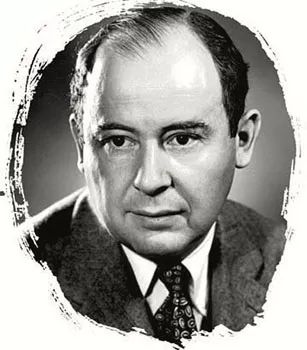Around 1922–1923, Professor Herbert Fraenkel of Marburg University received a manuscript titled “The Axiomatization of Set Theory” from Professor Schmidt in Berlin, Germany. The author was John von Neumann (1903–1957), whom he did not know. In his letter, Schmidt mentioned that the paper was “difficult to understand” and asked for Fraenkel’s opinion on it.
When Fraenkel recalled the situation years later, he said, “I can’t insist that I understood everything, but I can confidently say that this is an extraordinary work and ‘judge a lion by its claws.’ While replying to express this, I also invited the young scholar to Marburg as a guest so that we could discuss some issues face to face.” The phrase “judge a lion by its claws” was a remark made by the Swiss mathematician Daniel Bernoulli about Newton two and a half centuries earlier. At that time, Bernoulli recognized Newton’s authorship of an anonymous mathematical paper at first glance. Fraenkel’s judgment was also correct. The 20-year-old Hungarian scholar he hosted later became widely known in the mathematical community through the circulation of this doctoral thesis among some influential figures.
John von Neumann was born into a wealthy Jewish family in Budapest, the capital of Hungary, on December 28, 1903. His father was a banker and also an amateur poet with a romantic flair. He consciously turned the family dinner table into an effective classroom for nurturing intelligence, encouraging family members, including himself, to bring up particularly interesting topics from their day for analysis and discussion. He often brought home samples or models of new products from the enterprises he funded, so that his family could see them. Sometimes he would recount the decisions made at the bank during the day and ask his children how they would react to a certain investment opportunity or risk of debt if it were up to them, and how they would weigh the pros and cons.
Immersed in such a relaxed and free environment, von Neumann was able to develop in a relatively comprehensive manner. He had a fondness for languages and was also deeply interested in history. At the age of six, he could chat with his father in ancient Greek, and before he turned ten, he had read all 44 volumes of the Universal History, demonstrating an extraordinary memory and mathematical ability.
Initially, considering practical employment and livelihood, von Neumann followed his father’s wish to study chemical engineering abroad. However, he eventually switched to a career in mathematical research. In 1930, von Neumann accepted a position as a visiting professor at the Institute for Advanced Study in Princeton and moved to the United States. In 1937, as war loomed, he was appointed as a consultant to the U.S. Army Ballistic Research Laboratory and in 1943, he became involved in the atomic bomb research project, performing calculations to elucidate the assembly of nuclear weapons.
During these intense wartime years, von Neumann did not forget to enjoy life. He loved parties, gourmet food, pranks, and playing poker. A magazine once humorously commented on his love for food and his weight gain, saying, “He can calculate everything except calories.” It was precisely the elements of risk, struggle, confrontation, and uncertainty in poker that prompted von Neumann to study game theory, or “the strategy of winning,” and led him to realize that the relevant theories could be applied to fields such as economics, political science, and foreign policy.
In early August 1944, the young American mathematician Herman Goldstine encountered the already world-famous John von Neumann at the Aberdeen train station while waiting for a train to Philadelphia. After introducing himself, Goldstine seized the opportunity to consult von Neumann and informed him that he was working on the development of an electronic computer capable of performing 333 multiplications per second. This machine was the world’s first electronic computer, known as ENIAC (Electronic Numerical Integrator and Computer).
Von Neumann took an immediate interest and expressed his desire to see the machine. A few days later, his wish was granted. Before the visit, American engineer J.P. Eckert, one of the principal designers of ENIAC, told Goldstine that von Neumann’s first question would reveal whether he was a true genius. When they met, von Neumann, after just a brief glance at the computer, inquired about its logical structure—precisely the mark of genius that Eckert had anticipated.
Shortly after seeing the ENIAC, von Neumann predicted that electronic computers would become a billion times faster within our lifetimes. He also keenly realized that computers should be based on logic that is transformed into precise mathematical forms. Moreover, he understood that the increase in computing speed depends not only on the improvement of machine speed but also on the refinement of computational methods. Immediately, he began to analyze the shortcomings of the ENIAC and planned to build his own computer.
The initial innovation targeted the design philosophy of computers. Addressing the contradiction between the increase in computing speed and the slow manual programming—ENIAC was on the verge of failure because it could not solve this problem, with its main drawback being the separation of programs and calculations, where program instructions were stored in the external circuits of the machine—von Neumann proposed a crucial insight: the working memory of a computer (commonly known as “RAM”) could not only store batches of data required for calculations but also store the program instructions themselves. Once the program itself is stored in memory, the execution of loop operations and other instructions would only require simple jumps from one location to another within the memory.
The design concept of the stored-program computer established a complete theoretical framework for modern computers and became the fundamental principle of computer design. According to von Neumann’s vision, a computer should consist of a memory unit, an arithmetic unit, a control unit, input, and output (this is what later became known as the “von Neumann architecture”). At that time, von Neumann had already begun to think about and compare computers with the human brain. He once pessimistically lamented the complexity of the human brain as “frightening,” believing that our chances of understanding the brain were as slim as those of people around us who “have never heard of arithmetic” but try to understand the ENIAC.
However, von Neumann did not give up his exploration. In the spring of 1945, he was invited to draft the logical framework for the Electronic Discrete Variable Automatic Computer (EDVAC), historically known as the “101-page report.” In it, he wrote: “These three special parts—the central arithmetic unit, the central control unit (together with the computer), and the memory—are equivalent to the associative neurons in the human nervous system. It is also necessary to discuss the equivalents of sensory or afferent, and motor or efferent neurons. These are the input and output organs of the device…” This important document is still considered a milestone in the development of modern computer science.
Unfortunately, time was running out for this polymath. In October 1955, while preparing manuscripts for the Silliman Lectures at Yale University scheduled for the following spring, von Neumann was diagnosed with cancer. In 1956, he was admitted to the hospital.
Almost at the very end of his life, von Neumann wrote the manuscript on the relationship between the human nervous system and computers while on his deathbed. It mainly explores the computational processes of computers and the thinking processes of the human brain from logical and statistical mathematical perspectives and makes some comparative studies between “man-made automata” (computers) and “natural automata” (the human brain). Many of the technical inferences in the book are predictive, and there are also many places where the ideas were not fully elaborated or explained clearly.
On February 8, 1957, John von Neumann passed away in Washington. The following year, his manuscript was published by Yale University Press under the title The Computer and the Brain. Thirty-four years later, in his biography of von Neumann, Norman Macrae commented on the book The Computer and the Brain:
“Some parts of this book, especially the ending, are brilliant. Unfortunately, other sections—written during the period when his cancer was worsening—do not fully reflect John’s intellectual brilliance. A prominent American scientist, not known for his modesty, once said: ‘We could never keep up with his thinking speed, except during that sad final year when he was ill and in the hospital.’”
As one of the greatest polymaths of the 20th century, with significant contributions to mathematics, modern computing, game theory, and other fields, von Neumann’s discoveries and inventions profoundly changed the world, transforming human life, work, and ways of thinking, and greatly advancing social progress and the development of civilization. Napoleon’s famous saying—“Genius is like a meteor, destined to burn itself out to illuminate the age in which it lives”—could not be more fitting for John von Neumann.





No comments